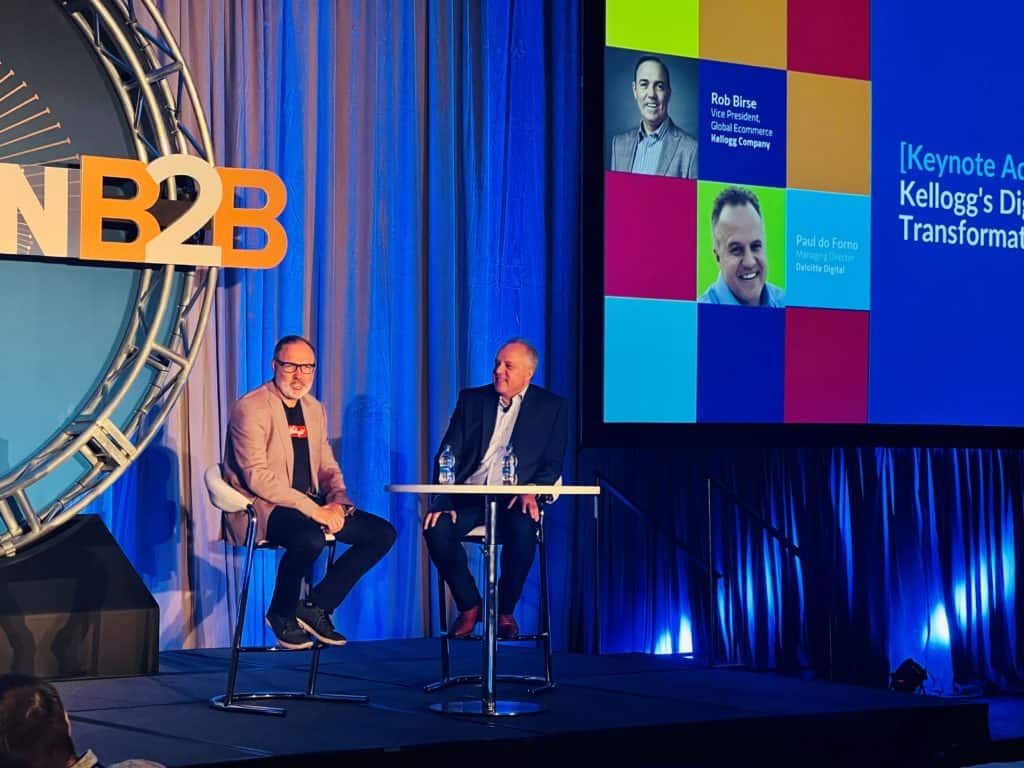In an era when B2B buyers are becoming digital-first customers, manufacturers and suppliers not only need to be more forward thinking to stay ahead of the competition. They also must seize the opportunities ecommerce presents to grow sales and increase customer retention.
One way to achieve those goals is through data analytics. Addressing an audience during a keynote “fireside chat” at the EnvisionB2B Conference & Exhibition in Chicago Friday, Rob Birse, vice president, Global Ecommerce for Kellogg Co., talked about the multinational food manufacturer’s use of data to create a better value proposition for its customers that goes beyond purchasing through digital channels.

Rob Birse of Kellogg’s, left, sits with Paul do Forno of Deloitte Digital in a “fireside chat” at EnvisionB2B.
Capitalizing on digital data
As a manufacturer, Kellogg collects data on the retail outlets that sell its food products. By analyzing what the company knows about a retailer’s operation through in-store and B2B sales data, Kellogg can make recommendations to help a retailer improve its operations.
“Our data strategy is to make data more in the moment to create a value proposition for our customers,” Birse said. “Use of data is about the insights that can be gathered from it, and we have a lot of dynamic data available to us.”
Building on that point, Paul do Forno, managing director for Deloitte Digital, who chatted with Birse for the keynote, added that before a company can use data to make great recommendations to its B2B customers, it must first clean up the data so it can drive insights from it.
As part of its strategy to use data to help its retailers, Kellogg uses sales data from retailers, especially small retailers such as bodegas, to recommend what products should be on the shelf, as well as promotions that can stimulate sales while aligning with Kellogg’s social goals.
A culture of innovation
Kellogg, for example, has a goal of providing millions of meals to needy individuals globally. In some instances, the company has developed promotions with its retailers to donate food to the needy for each in-store purchase. “We view this strategy as the currency of promotions,” Birse said.
 Another way Kellogg is pushing its ecommerce business forward is by building what Birse described as a culture of innovation. The first step in such a strategy is to ensure that management and employees dedicate enough time to build that culture; otherwise, efforts to create it can lag, Birse said.
Another way Kellogg is pushing its ecommerce business forward is by building what Birse described as a culture of innovation. The first step in such a strategy is to ensure that management and employees dedicate enough time to build that culture; otherwise, efforts to create it can lag, Birse said.
A key part of building a culture of innovation is allowing for an opportunity to fail, which Birse said is not a bad outcome. “Failure helps build the culture of innovation,” he said.
Failures need to be discussed so companies can learn what went wrong and what they can learn from them, Birse said.
Creating a culture of innovation also requires a company to set expectations around its efforts to innovate, do Forno said. Those expectations, he added, should include a change management strategy.
Changing an industry
Another aspect of Kellogg’s efforts to create a culture of innovation is believing in strategies once they are set in motion. “My notion is not to challenge a strategy once it is set, but to turn that innovation into action,” Birse said. “If you believe you can change an industry with your strategy, then you are onto something.”
Seeking out third-party technology partners is another way Kellogg is fostering its culture of innovation. Birse said that Kellogg uses the power of its brand to recruit technology partners and build solutions that can change an industry. “That’s why you invest in technology partners,” he said. “There is nothing wrong with joint ventures.”
Getting B2B buyers comfortable with adopting digital channels is another key area where Kellogg is focusing its attention. Helping buyers know how much to purchase at any given time and how to base purchasing decisions on production levels can play a huge role in helping buyers become comfortable with ecommerce, Birse said.
“There are so many ways to identify customer pain points and use that knowledge to solve problems and apply technology, he added.
Peter Lucas is a Highland Park, Illinois-based freelance journalist covering business and technology.
Sign up
Sign up for a complimentary subscription to Digital Commerce 360 B2B News, published 4x/week. It covers technology and business trends in the growing B2B ecommerce industry. Contact editor Paul Demery at [email protected] and follow him on Twitter @pdemery.
Follow us on LinkedIn and be the first to know when new Digital Commerce 360 B2B News content is published.
Favorite